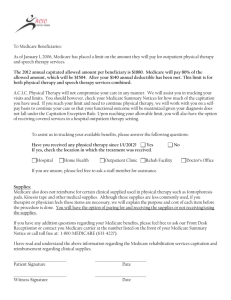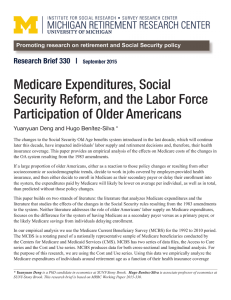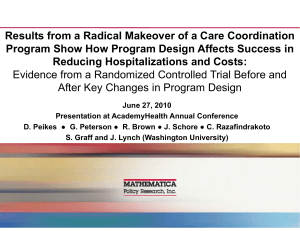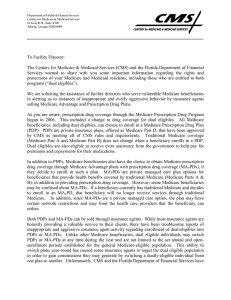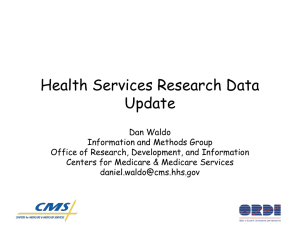Appendix: Description of the Disability Status (DS) model The DS
advertisement
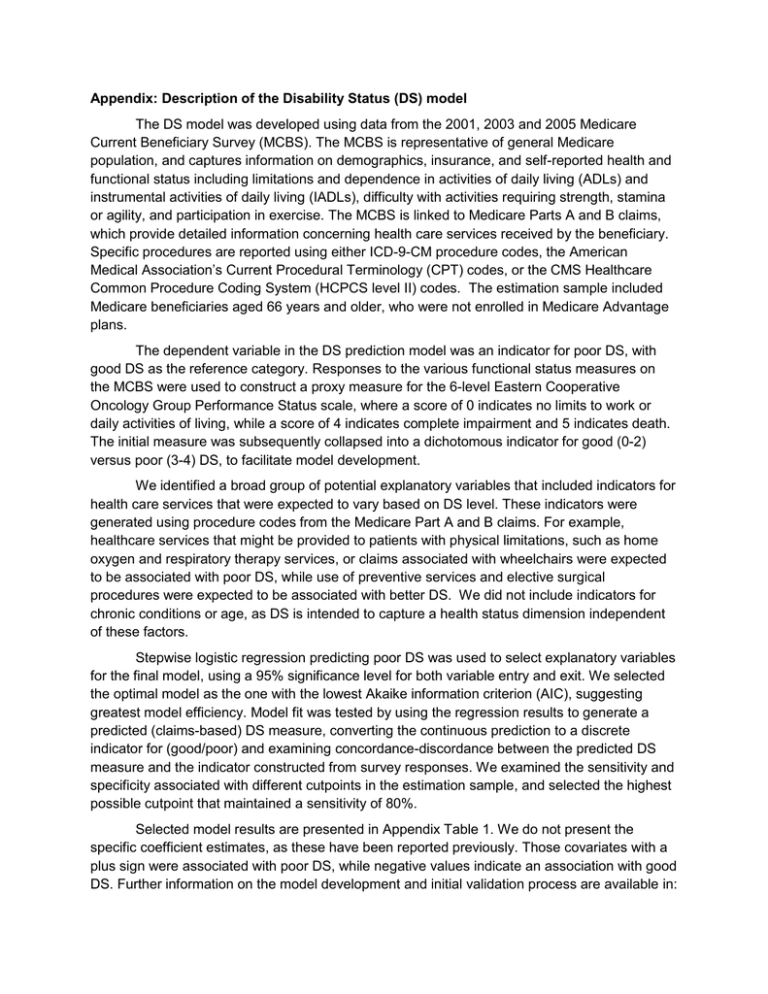
Appendix: Description of the Disability Status (DS) model The DS model was developed using data from the 2001, 2003 and 2005 Medicare Current Beneficiary Survey (MCBS). The MCBS is representative of general Medicare population, and captures information on demographics, insurance, and self-reported health and functional status including limitations and dependence in activities of daily living (ADLs) and instrumental activities of daily living (IADLs), difficulty with activities requiring strength, stamina or agility, and participation in exercise. The MCBS is linked to Medicare Parts A and B claims, which provide detailed information concerning health care services received by the beneficiary. Specific procedures are reported using either ICD-9-CM procedure codes, the American Medical Association’s Current Procedural Terminology (CPT) codes, or the CMS Healthcare Common Procedure Coding System (HCPCS level II) codes. The estimation sample included Medicare beneficiaries aged 66 years and older, who were not enrolled in Medicare Advantage plans. The dependent variable in the DS prediction model was an indicator for poor DS, with good DS as the reference category. Responses to the various functional status measures on the MCBS were used to construct a proxy measure for the 6-level Eastern Cooperative Oncology Group Performance Status scale, where a score of 0 indicates no limits to work or daily activities of living, while a score of 4 indicates complete impairment and 5 indicates death. The initial measure was subsequently collapsed into a dichotomous indicator for good (0-2) versus poor (3-4) DS, to facilitate model development. We identified a broad group of potential explanatory variables that included indicators for health care services that were expected to vary based on DS level. These indicators were generated using procedure codes from the Medicare Part A and B claims. For example, healthcare services that might be provided to patients with physical limitations, such as home oxygen and respiratory therapy services, or claims associated with wheelchairs were expected to be associated with poor DS, while use of preventive services and elective surgical procedures were expected to be associated with better DS. We did not include indicators for chronic conditions or age, as DS is intended to capture a health status dimension independent of these factors. Stepwise logistic regression predicting poor DS was used to select explanatory variables for the final model, using a 95% significance level for both variable entry and exit. We selected the optimal model as the one with the lowest Akaike information criterion (AIC), suggesting greatest model efficiency. Model fit was tested by using the regression results to generate a predicted (claims-based) DS measure, converting the continuous prediction to a discrete indicator for (good/poor) and examining concordance-discordance between the predicted DS measure and the indicator constructed from survey responses. We examined the sensitivity and specificity associated with different cutpoints in the estimation sample, and selected the highest possible cutpoint that maintained a sensitivity of 80%. Selected model results are presented in Appendix Table 1. We do not present the specific coefficient estimates, as these have been reported previously. Those covariates with a plus sign were associated with poor DS, while negative values indicate an association with good DS. Further information on the model development and initial validation process are available in: Davidoff AJ, Zuckerman IH, Pandya N, Hendrick FH, Ke X, Hurria A, Lichtman S, Hussain A, Weiner J, Edelman M. A Novel Approach to Improve Health Status Measurement in Observational Claims-based Studies of Cancer Treatment and Outcomes. Journal of Geriatric Oncology, 2013, January 28 (Epub ahead of print]. Apppendix Table 1: Logistic Regression Model for Poor Disability Statusa Coefficient Evaluation and Management (E&M)/other visits by provider specialty or site of care Nursing home visit Dermatology E&M visit Neurology E&M visit Rheumatology E&M visit Chiropractic Home visit Hospice visit Minor skin procedures Ambulatory musculoskeletal procedures Screenings Immunizations/vaccinations Major orthopedic procedures - other Durable Medical Equipment Bath and toilet aids Wheelchairs Hospital bed Enteral and parenteral Medical/surgical supplies Other Standard imaging - nuclear medicine Other Ambulance Electrocardiography monitoring & cardiovascular stress tests Endoscopy - upper gastrointestinal Endoscopy - sigmoidoscopy, colonscopy Medicaid enrollment Count of E&M office visits + + + + + + + *** * *** * + + + + + - * + *** *** *** *** *** *** ** *** *** *** *** * *** * + + *** ** ** *** + 0-2 3-6 ref 7+ Sex (female is reference) Source: Medicare Current Beneficiary Survey, 2001, 2003, 2005; Coefficient estimate significant at * p<=.10; ** p<=0.05; *** p<0.01 ***






